AMD aims Geode LX at “x86 everywhere”
May 23, 2005 — by Henry Kingman — from the LinuxDevices Archive — views AMD is sampling a low-power, low-cost, small-footprint embedded processor chipset aimed at extending the x86 architecture to a broad range of resource-constrained consumer and industrial applications, including moderately-sized mobile devices. The [email protected] and its CS5536 companion chip are available with an evaluation board and Linux development kit, and are the first of AMD's embedded processor chipsets to be designed by the group it acquired with the Geode line.
AMD is sampling a low-power, low-cost, small-footprint embedded processor chipset aimed at extending the x86 architecture to a broad range of resource-constrained consumer and industrial applications, including moderately-sized mobile devices. The [email protected] and its CS5536 companion chip are available with an evaluation board and Linux development kit, and are the first of AMD's embedded processor chipsets to be designed by the group it acquired with the Geode line.
(Click for larger image of the Geode LX800)
x86 everywhere
AMD's marketing manager, Charles Dittmer, says AMD has long anticipated that technology, process, and design improvements would increase the viability of x86 in power- and size-constrained embedded systems. “It's our vision that x86 will migrate over time, with technology advances, from the typical PC and server space down into cross-over devices and consumer devices. The LX800 is a proof point in [that] 'x86 everywhere' strategy. It will bring the Windows and Linux experience into new classes of devices,” Dittmer said.
AMD is not the only embedded chip maker targeting the “x86 everywhere” market. Via announced its CoreFusion chipset line in March, aimed at the embedded market. The company is currently sampling its “Mark” and “Luke” CoreFusion chips, which are dual-chip chipsets, and plans to sample its single-chip “PC on a chip” before 2006.
According to Via processor division chief Glenn Henry, who spoke with LinuxDevices last year, the x86 architecture is advantageous for devices with user interfaces, and for those tasked with complex processes. AMD's Dittmer adds that the x86 platform also benefits from rich software availability, and an enormous developer ecosystem.
Positioning within AMD's product line
The LX800 is positioned midway between the legacy GX Geode chips acquired from National Semiconductor, and the NX Geode chips, announced one year ago, which use the same processor cores as AMD's mobile Athlon chips.
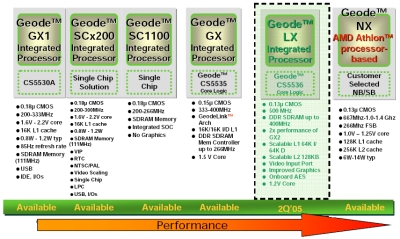
The LX800 is positioned between AMD's GX and NX lines
(Click to enlarge)
Although not mentioned by Dittmer, AMD also recently added several of its high-end 32/64-bit Opteron processors to its embedded roadmap, assuring availability of the parts for five years to accommodate the longevity requirements of embedded applications. AMD is aiming the Opteron processors at performance-intensive embedded applications such in telecommunications, storage, digital imaging applications.
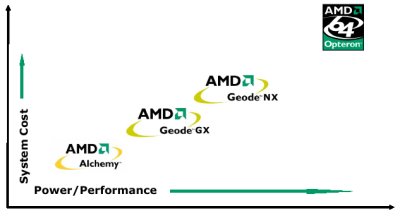
A broader perspective of AMD's embedded processor roadmap. The LX fits between the GX and the NX
Also unmentioned by Dittmer are the low-end MIPS architecture based Alchemy processors acquired from Alchemy Semiconductor in early 2002. AMD's Alchemy processors compete with Intel's XScale processors in highly cost-sensitive handheld applications.
Target markets
According to Dittmer, 17 early customers are already using the LX800 chipset to build thin clients, tablets, IP-STBs, HDTVs, media servers, router/firewalls, industrial PCs, PVRs, LCD wall displays, POS kiosks, ultra-mobile PCs, and single-board computers (SBCs).
Dittmer describes one early design win as an enterprise-class router, in which the LX800 offers headroom for future software load increases over a product lifespan of five to seven years.
What's inside the chips?
The [email protected] and its CS5536 companion chip are the first chips designed by the Geode processor design team AMD acquired along with the Geode line from National Semiconductor in mid-2003. AMD claims the LX800 processor offers almost twice the integer performance of it's venerable GX533 (formerly GX2), while drawing less power.
According to Dittmer, the Geode design team was able to radically increase performance by increasing the L1 cache four times, increasing the data and instruction caches from 16KB to 64KB, and clocking the LX800 at 500MHz, instead of the GX533's 400MHz. Power savings were realized through a process technology size reduction, from 0.15 microns to 0.13 microns, and through a GeodeLink power manager that shuts down unused parts of the processor, such as PLLs (phase-locked loops).
The Geode team also increased performance by adding support for 400MHz DDR RAM, and improving the chip's GeodeLink Interface Unit (GLIU) to support 9.6GBps throughput, up from 6 gigabyte/second in the GX533. “The LX800 has a greater ability to move large amounts of data in and out of the graphics and memory systems,” Dittmer said.
The chipset is designed as a cohesive duo, and neither chip can be used with third-party parts, according to Dittmer. However, an external graphics chip can be added, and the LX800 is able to composite the off-chip graphics pipeline with its own pipeline, Dittmer notes. Additionally, the board includes VIP and VOP ports (video input and video output) capabilities, making it suitable for a variety of media-center applications.
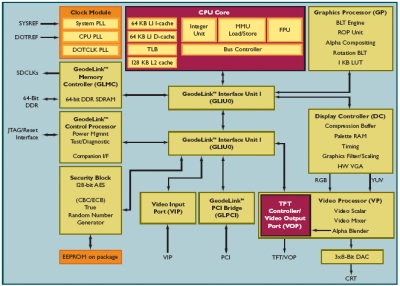
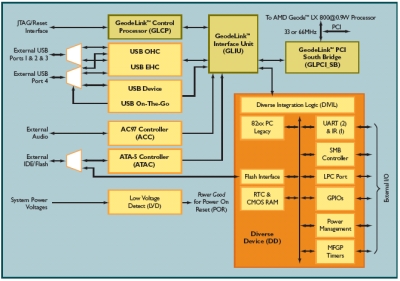
Geode LX chipset architecture — LX800 CPU/Northbridge above, CS5536 Southbridge below
(Click to each image to enlarge)
Functions integrated within the LX500 CPU/Northbridge chip, according to AMD, include:
- CPU core
- GeodeLink control processor
- GeodeLink interface units
- GeodeLink memory controller
- Graphics processor
- Optimized 2D graphics
- Rotation BLIT graphics/video
- Approx. 2x increase in 2D performance
- Optimized 2D graphics
- Display controller, capable of:
- Single high density video output port (VOP 2.0 compatible)
- 1920 x 1440 x 32 pixel 85Hz CRT output
- 1600 x 1200 pixel TFT LCD output
- Single high density video output port (VOP 2.0 compatible)
- Video processor
- High density (8/16-bit) video input port (VIP)
- GeodeLink PCI bridge
- Security block providing
- True Random Number Generator
- AES 128 ECB/CBC encrypt/decrypt
- True Random Number Generator
- 66 MHz PCI bus interface
Additionally, the CS5536 companion Southbridge chip provides:
- PCI bus interface
- ATA-5 Controller
- Flash Interface
- Four USB 1.1/2.0 ports
- 3 host
- 1 host/device with “On-The-Go” (OTG) support
- Audio Codec 97 (AC97 v2.3 compliant)
- LPC (Low Pin Count) port
- 16 general purpose I/O lines
- NAND/NOR Flash memory interface
- IR Communication Port
- GeodeLink
- System Management Bus (SMB) Controller
- 8 multi-function general purpose
timers - Real-time clock (RTC) with CMOS RAM
- Power management controller
- ACPI v2.0 compliant
Naming scheme
Like its GX-series ancestors, the LX800 uses the benchmark-based nomenclature announced by AMD in May of 2004. The “800” number is intended to reflect actual, real-world performance in relationship to the GX533, which in turn was benchmarked against Via's C3-based embedded chip, clocked at 533MHz.
The second number reflects typical power draw with the chip running “at about 80 percent,” according to Dittmer. The rating applies only to the processor portion of the LX800, however, and does not include the power drain from blocks typically found in northbridges, such as memory controllers and graphics subsections. Including those blocks boosts typical power draw to 1.6 Watts, Dittmer says.
In terms of TDP (thermal design power), the LX800 has a TDP of 2.4 watts, while the CS5536 has a 600 milliwatt TDP, for a total chipset TDP of 2.5 watts.
The higher-end of Via's two two-chip CoreFusion products, Luke, has a claimed TDP of around 6 Watts at 533MHz, or 8 Watts at 800MHz. However, a move to 90nm process technology in mid-2005 is expected to reduce those figures significantly. On the smaller technology, Via's Luke chipset is expected to have a TDP of 3.5 Watts at 1GHz, or 1 Watt at 433MHz. Additionally, Via claims that with aggressive power management, typical power usage could drop as low as 100 to 200 mW.
Dittmer declined to comment on how the LX800 compares to Via's CoreFusion chips, although AMD's benchmark-based naming scheme — which uses Via's 533MHz C3 part as the standard — certainly invites comparison.
A real comparison of the relative characteristics of AMD's and Via's “x86 everywhere” chips is probably best left to the benchmarking labs. However, if appears that Via offers greater performance scalability, while AMD offers significantly lower power usage, at least for now.
Anecdotally, Dittmer says that he has a development board on his desk hooked up to a DVD drive, and that the chipset remains cool to the touch when decoding a DVD. It does not require a heatsink, he says, let alone a fan.
Evaluation board
AMD is offering an ETX COM (computer-on-module) development board for the LX800, apparently developed in partnership with board house Logic Product Development. The Geode LX DB800 Development Board (ordering number LX-DB800-EVAL-KIT) includes Flash and RAM, the LX800 chipset, an AC97 codec chip, and an Ethernet controller — all the critical timing and layout, Dittmer said.
Also available is a mini-ITX carrier board, which breaks out ports for the LX800's interfaces, including a single PCI slot.
Dittmer notes that low-volume device makers can use the evaluation module in production systems, with a baseboard of their own design, while higher-volume device makers can build a custom board using schematics and other design documentation supplied by AMD.
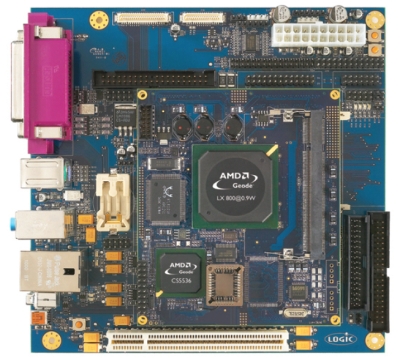
AMD offers a ready-to-use Geode LX development boardset
(Click to enlarge)
The development board is supported by a Linux BSP (board support package) and development tools from an unspecified Linux partner, Dittmer noted. The board pictured above appears to be made by Logic Product Development, which has also partnered with AMD on Geode NX development boards.
Availability
The LX800 chipset is sampling now, with production availability in June, according to Dittmer, priced at $45 in 10K quantities. The LX800 is packaged in a 481-pin BGA measuring 40 x 40mm, and the CS5536 is packaged in a 208-pin BGA measuring 23x23mm. The chipset and its development board have been validated for compatibility with Linux kernel 2.6, Windows CE 4.2 and 5.0, Windows XP, and Windows XP Embedded, according to Dittmer.
This article was originally published on LinuxDevices.com and has been donated to the open source community by QuinStreet Inc. Please visit LinuxToday.com for up-to-date news and articles about Linux and open source.